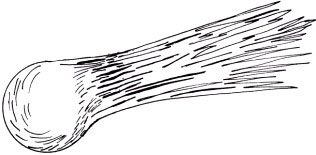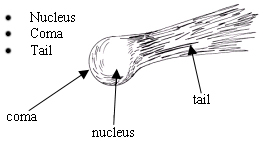Comets and their orbits
Students use information to label a diagram and draw the orbit of a comet.
| Comets are balls of frozen ice and gas that contain rocky fragments. Most of the mass of a comet is in its nucleus. A comet's orbit is longer and narrower than the orbit of a planet. As the comet approaches the Sun, some of the nucleus evaporates forming the coma around it, together with a glowing tail of dust and gases. This tail points away from the Sun. |
|
a) |
Use the information above to label this cross section of a comet. |
||
|
|
|||
| b) | Part of the orbit of a comet has been drawn. Complete the rest of the comet's orbit. | ||
 |
|||
| c) | The diagrams below show a comet in two different parts of its orbit. Redraw these comets onto the orbit in question b). (Use the information in the box to help you). | ||
|






